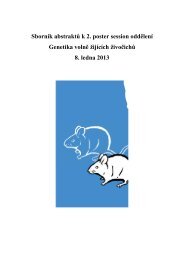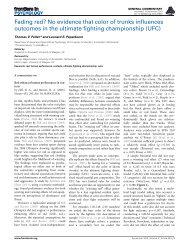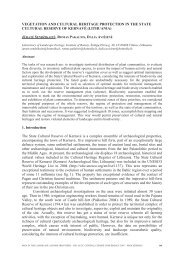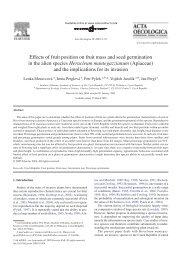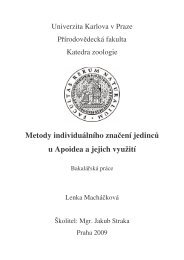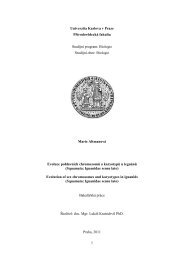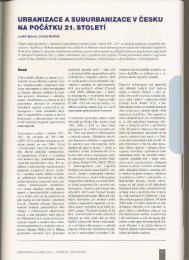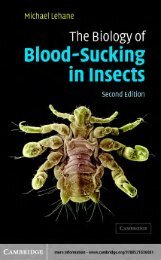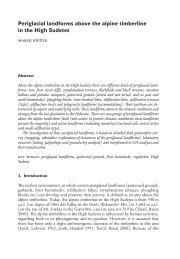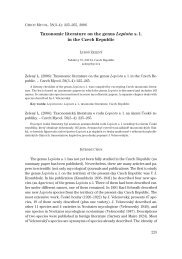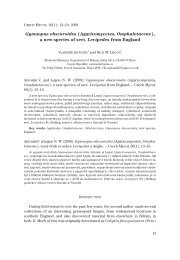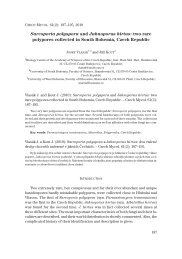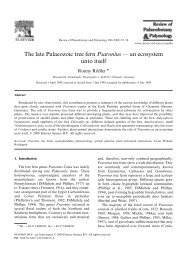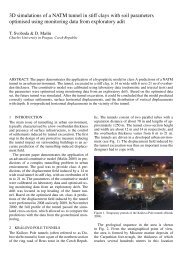The wood-rotting bluing Psilocybe species in Central Europe – an ...
The wood-rotting bluing Psilocybe species in Central Europe – an ...
The wood-rotting bluing Psilocybe species in Central Europe – an ...
You also want an ePaper? Increase the reach of your titles
YUMPU automatically turns print PDFs into web optimized ePapers that Google loves.
Despite <strong>an</strong> overlap <strong>in</strong> spore size of particular <strong>species</strong> (couplets 3 <strong>an</strong>d 6 <strong>in</strong> the key<br />
below), measurement of a representative number of spores (20<strong>–</strong>30) should clearly<br />
reveal the difference between the <strong>species</strong> as shown <strong>in</strong> Figs. 1 <strong>an</strong>d 2. Especially the<br />
relative frequency of particular length <strong>an</strong>d/or width sizes should be considered.<br />
Macrocharacters are given as import<strong>an</strong>t supplementary features; only dist<strong>in</strong>guish<strong>in</strong>g<br />
macrocharacters are mentioned. Data on distribution <strong>an</strong>d phenology are<br />
ma<strong>in</strong>ly based on the author’s own observations from <strong>Central</strong> <strong>Europe</strong>.<br />
An extensive list of previously published illustrations of the <strong>Psilocybe</strong> <strong>species</strong> referred<br />
<strong>in</strong> the key is <strong>in</strong>cluded. Clearly misapplied illustrations are mentioned as “excluded”;<br />
question marks <strong>in</strong>dicate the author’s doubts about some of the illustrations.<br />
RESULTS AND DISCUSSION<br />
C h a r a c t e r i s t i c s o f i n c l u d e d t a x a . Autumnal <strong>species</strong> (September<strong>–</strong>December)<br />
grow<strong>in</strong>g <strong>in</strong> detritus, mostly on <strong>wood</strong>y debris, also on fallen decayed<br />
trunks, seed cones or acorns, mostly <strong>in</strong> broadleaved or mixed forests, less commonly<br />
<strong>in</strong> coniferous forests, often along forest paths or roads, <strong>in</strong> gulches near<br />
creeks, <strong>in</strong> underbrush with Urtica spp. or Rubus spp., also <strong>in</strong> parks, gardens <strong>an</strong>d<br />
cemeteries (<strong>wood</strong> chips), mostly gregarious, on various types of bedrock. Little to<br />
almost middle-sized, might resemble Hypholoma subericaeum, H. myosotis or<br />
some Psathyrella <strong>species</strong>. Sta<strong>in</strong><strong>in</strong>g blue, blue-green or olive-green on stipe or<br />
pileus spont<strong>an</strong>eously or when bruised. All <strong>species</strong> conta<strong>in</strong> the psychoactive compounds<br />
psilocyb<strong>in</strong> <strong>an</strong>d psiloc<strong>in</strong> (see Wurst et al. 2002, Stříbrný et al. 2003,<br />
Courtecuisse <strong>an</strong>d Deveaux 2004).<br />
KEY<br />
1a Pleurocystidia present, quite frequent to very abund<strong>an</strong>t, only rarely scarce, clavate-mucronate,<br />
broadly fusiform or robustly lageniform (Fig. 3a). Cheilocystidia lageniform, mostly with a rather<br />
short neck (< 10 μm), also pleurocystidia-shaped. Grow<strong>in</strong>g mostly <strong>in</strong> gardens, parks <strong>an</strong>d cemeteries.<br />
.......................................................................................... stirps Cy<strong>an</strong>escens (Borovička 2005) 2<br />
1b Pleurocystidia scarce to abund<strong>an</strong>t, lageniform (Fig. 3b), or absent. Cheilocystidia lageniform, with<br />
a short or a long neck (> 10 μm), also fusiform or very narrowly cyl<strong>in</strong>drical, equal or flexuous (Figs.<br />
3d<strong>–</strong>e). Grow<strong>in</strong>g <strong>in</strong> natural habitats or m<strong>an</strong>-made forests, often <strong>in</strong> pathsides, along creeks etc.<br />
.......................................................................................................... stirps Serbica (Borovička 2005) 3<br />
2a Spores ellipsoid to broadly ellipsoid, (9.8<strong>–</strong>)10.0<strong>–</strong>12.5(<strong>–</strong>13.5) × (6.5<strong>–</strong>)7.0<strong>–</strong>7.5(<strong>–</strong>8.0) μm [Q =<br />
1.3<strong>–</strong>1.6<strong>–</strong>1.8]. Pileus usually up to 5 cm across, not acutely umbonate, marg<strong>in</strong> wavy <strong>an</strong>d/or exp<strong>an</strong>ded<br />
at maturity. Stipe up to 10 cm long, whitish, silky fibrillose; fibrillose <strong>an</strong>nular zone absent.<br />
.................................................................................................................. <strong>Psilocybe</strong> cy<strong>an</strong>escens Wakef.<br />
2b Spores ellipsoid, (11.0<strong>–</strong>)12.0<strong>–</strong>13.5(<strong>–</strong>14.8) × (6.8<strong>–</strong>)7.2<strong>–</strong>7.7(<strong>–</strong>8.0) μm [Q = 1.65<strong>–</strong>1.8<strong>–</strong>1.95]. Fruitbodies<br />
relatively large, pileus 3<strong>–</strong>6(<strong>–</strong>10) cm across, mostly acutely umbonate, marg<strong>in</strong> not wavy. Stipe up to<br />
20 cm long, silky fibrillose but at maturity also with silvery fibrillose velar remn<strong>an</strong>ts on dark back-<br />
176<br />
CZECH MYCOL. 60(2): 173<strong>–</strong>192, 2008



